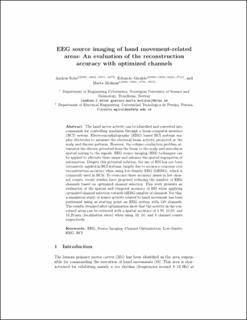| dc.contributor.author | Soler, Andres | |
| dc.contributor.author | Giraldo, Eduardo | |
| dc.contributor.author | Molinas Cabrera, Maria Marta | |
| dc.date.accessioned | 2024-03-05T08:16:06Z | |
| dc.date.available | 2024-03-05T08:16:06Z | |
| dc.date.created | 2024-01-12T11:25:58Z | |
| dc.date.issued | 2023 | |
| dc.identifier.citation | Lecture Notes in Computer Science book series (LNAI,volume 13974) | en_US |
| dc.identifier.issn | 0302-9743 | |
| dc.identifier.uri | https://hdl.handle.net/11250/3121001 | |
| dc.description.abstract | The hand motor activity can be identified and converted into commands for controlling machines through a brain-computer-interface (BCI) system. Electroencephalography (EEG) based BCI systems employ electrodes to measure the electrical brain activity projected at the scalp and discern patterns. However, the volume conduction problem attenuates the electric potential from the brain to the scalp and introduces spatial mixing to the signals. EEG source imaging (ESI) techniques can be applied to alleviate these issues and enhance the spatial segregation of information. Despite this potential solution, the use of ESI has not been extensively applied in BCI systems, largely due to accuracy concerns over reconstruction accuracy when using low-density EEG (ldEEG), which is commonly used in BCIs. To overcome these accuracy issues in low channel counts, recent studies have proposed reducing the number of EEG channels based on optimized channel selection. This work presents an evaluation of the spatial and temporal accuracy of ESI when applying optimized channel selection towards ldEEG number of channels. For this, a simulation study of source activity related to hand movement has been performed using as starting point an EEG system with 339 channels. The results obtained after optimization show that the activity in the concerned areas can be retrieved with a spatial accuracy of 3.99, 10.69, and 14.29 mm (localization error) when using 32, 16, and 8 channel counts respectively. | en_US |
| dc.language.iso | eng | en_US |
| dc.publisher | Springer | en_US |
| dc.relation.uri | https://link.springer.com/chapter/10.1007/978-3-031-43075-6_37 | |
| dc.rights | Navngivelse 4.0 Internasjonal | * |
| dc.rights.uri | http://creativecommons.org/licenses/by/4.0/deed.no | * |
| dc.title | EEG source imaging of hand movement-related areas: An evaluation of the reconstruction accuracy with optimized channels | en_US |
| dc.title.alternative | EEG source imaging of hand movement-related areas: An evaluation of the reconstruction accuracy with optimized channels | en_US |
| dc.type | Journal article | en_US |
| dc.type | Peer reviewed | en_US |
| dc.description.version | acceptedVersion | en_US |
| dc.source.journal | Brain Informatics. BI 2023. Lecture Notes in Computer Science (LNCS) | en_US |
| dc.identifier.doi | 10.1007/978-3-031-43075-6_37 | |
| dc.identifier.cristin | 2225234 | |
| cristin.ispublished | true | |
| cristin.fulltext | postprint | |
| cristin.qualitycode | 1 | |

